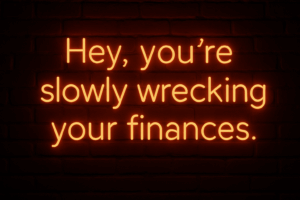Bad habits don’t usually come with a neon sign and a bank notification that says, “Hey, you’re slowly wrecking your finances.”

But it’s 2025 – you can get anything on Amazon.
They show up looking innocent. Practical, even. A $4 latte here. A sale you just had to jump on there. A monthly box of stuff you could technically live without but hey—it sparks joy, right?
Until one day your credit card balance looks like a student loan and you’re Googling “how to cancel every subscription I’ve ever touched.”
The Problem with Waiting Until It’s Obvious
Most people only notice bad financial habits once they’ve become expensive. But by then, you’ve already built a lifestyle (and possibly a pile of debt) around them.
What you want is an early warning system. Like a smoke detector for your budget, not one of those silent, passive-aggressive habits that ruins your money behind your back.
Red Flag #1: “I Deserve This” Spending
You had a tough day. You crushed your to-do list. You resisted the urge to rage-email your boss. Obviously, it’s time for a little retail therapy.
Let’s pause. Ask yourself this:
“Do I actually feel better after buying this—or am I now broke and stressed?”
This kind of “treat yo’self” spending isn’t always bad, but when it’s your default stress response? It’s less a reward, more a leaky faucet for your bank account.
Red Flag #2: You Hide Purchases (Even from Yourself)
If you’ve ever raced to grab a package off your porch before your partner sees it—or told yourself it’s “a business expense” even though you’re not sure what your business is—congrats: your financial habit just upgraded to “suspicious.”
Financial shame is usually a clue that something’s off. If you’re avoiding looking at your bank app, it’s probably not because it’s full of rainbows and unicorns.
Red Flag #3: The “One-Time” Excuse
It was on sale. It was limited edition. It was Prime Day. You swear you’ll only do it once.
Except you said that last month. And again, two weeks ago. The “one-time” lie is how lifestyle creep wins. And once your baseline spending resets, your budget doesn’t stand a chance.
Red Flag #4: You Can’t Name Your Subscriptions
If someone asked you to list every app, box, or service that bills you monthly, could you do it?
If the answer is “No, but I feel judged,” it’s time for a cancel spree. Subscription creep is a silent killer, and the worst part? You probably don’t even use half of them. (This is exactly what friction-free spending was designed to exploit.)
Red Flag #5: You’re Solving Emotional Problems with Financial Ones
Bored? Shop. Lonely? Shop. Stressed? Shop. Financially screwed? …Shop anyway. Emotional spending gives you that sweet, temporary dopamine hit while leaving your long-term goals in the dust.
The problem isn’t the coffee. Or the skincare set. Or the 3 a.m. sushi delivery. It’s the pattern. You’re throwing money at feelings. Which, spoiler: never works.
How to Reverse a Habit That’s Starting to Spiral
Once you spot the bad habit (congrats, self-awareness), here’s what to do next:
- Name the trigger. Is it boredom? Envy? FOMO? Stress?
- Create a 24-hour rule. Wait before buying anything unplanned. If you still want it tomorrow, reconsider. (If you forgot about it? Well… case closed.)
- Use the “Would I pay cash?” test. If it weren’t going on a card, would you still buy it?
Spotting vs. Justifying
Most bad financial habits don’t feel bad. That’s why they survive. You’ll dress them up in adult-sounding logic like “I work hard,” “It’s only $15,” or “This saves me time.”
Some things are worth the spend—but when they are, you’ll know because you feel good after the purchase too. (Like this list of Smart Splurges we actually endorse.)
Tools That Help (Without Making Things Worse)
You don’t need a spreadsheet the size of a Gantt chart. Just some light structure. Try:
- A whiteboard budget calendar (linked on Amazon)
- A printable expense tracker (or Google Sheets if you’re a masochist)
- A “No Spend Day” jar. Drop a buck in every time you don’t impulse buy something. Gamify it. Trick your brain.
Wrap-Up: Good Habits Are Boring (But Effective)
Bad financial habits usually start with the phrase “just this once.” Good ones start with “ugh, I guess I should.”
They’re not flashy. They don’t go viral. But they’re the ones that build wealth, not wipe it out.
If you want to live well without throwing your future self under the bus, spot the leaks early. Seal them fast. And remind yourself: no sale is worth the stress of wondering how to pay rent.

0 Comments